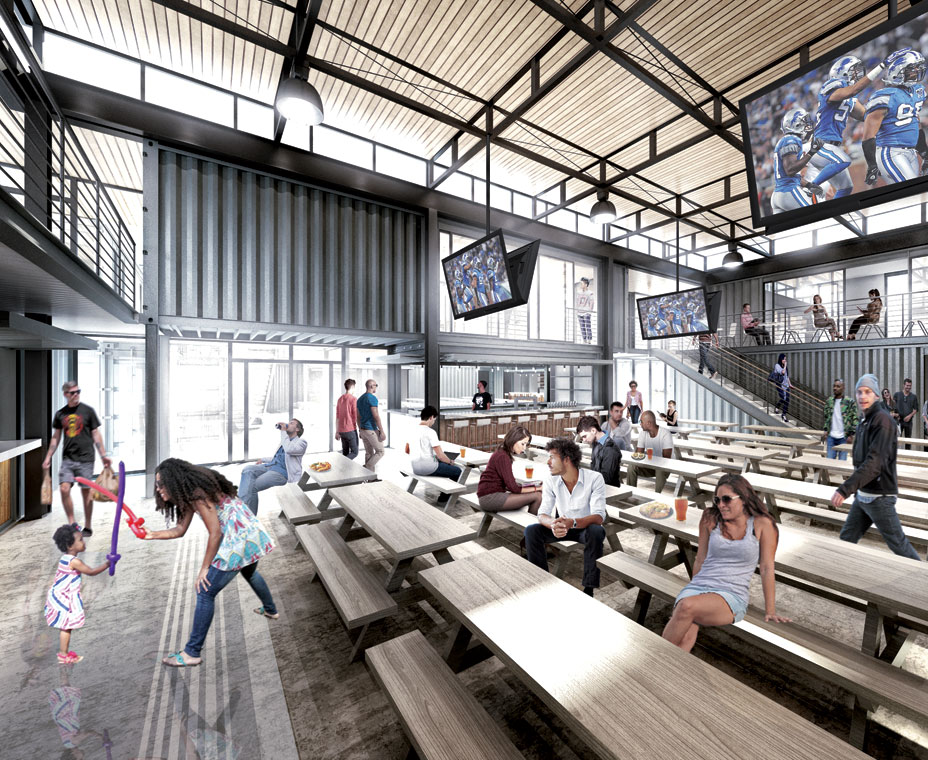They say history repeats itself, with trends coming and going and coming again in fashion, food, politics, pop culture, and even restaurant design.
That seems to be the case with shipping-container buildouts, a trend that popped up around 2011, fizzled out, and is now slowly making a return at both independent restaurants and larger chains.
The design’s initial debut in the limited-service industry is often credited to Starbucks, which in 2011 unveiled a 450-square-foot shipping-container design in Tukwila, Washington. The coffee giant went on to open a number of similar stores across the country, with the more compact design allowing it to expand to sites previously too small for a traditional Starbucks footprint.
However, many brands that followed suit discovered that the tools needed to economically produce these designs weren’t widely available six years ago, leading a majority to abandon the effort, says restaurant design expert Steve Starr.
But with regulations and technology continually improving—including new food-truck technology that allows brands to produce high-volume, quality food in a small space—the industry appears to be giving shipping containers another shot. Taco Bell, for one, debuted a 1,080-square-foot shipping-container pop-up store at the SXSW festival in Austin, Texas, in 2015. The brand recently announced that it will open its first permanent shipping-container store in South Gate, California, in the first half of 2017.
Starr says the steady increase in construction-labor costs is another factor in the trend’s resurgence. “What the shipping-container design provides is the ability to prefabricate, to do work in a shop and put it on a truck, ship it to the site, sit it down on the site, and then just make final connections,” he says. “That lowers subcontractor labor dramatically.”
Checkers/Rally’s offers franchisees this off-site construction opportunity with its recently launched 4.0 design model—an evolution of its modular store that allows franchisees to build a “hybrid” store using shipping containers as structural support.
Made of the same structural steel used to construct bridges and skyscrapers, shipping containers stack and sustain the weight of other shipping containers during construction. “We’ve taken six containers and pieced them together in our new design so they create the structural framework for the building itself,” says Jennifer Durham, senior vice president and chief development officer for Checkers/Rally’s.
While no franchisees have built a container format as of yet, the brand thinks its new 4.0 designs will allow them to better control costs and shave anywhere between five and 12 weeks off the store-opening timeline.
“This sped-up timeline is one of the biggest advantages of shipping-container design,” Starr says. “You can essentially mass produce them and then deploy them in a region quicker than you could build something from the ground up.”
A push toward greater sustainability in nearly every industry is yet another driving force behind the return of the trend. “It’s something that is reused, so it ties into the idea of being sustainable,” Starr says. “It’s also prefabricated, so it’s sustainable in that it takes significantly less energy to re-manufacture.”
It was the appeal of reusing a piece of the Motor City and capturing some of its deconstructed charm that led Jonathan Hartzell to create Detroit Shipping Co., a Detroit-based food hall, beer garden, and art gallery made up of 21 shipping containers designed by Independent Design Architects (IDEA). Set to open this spring, the food hall will feature a handful of fast casuals, including handcrafted hot dogs from Detroit Dog Co. and a chicken concept, Coop, from chef Max Hardy.
“The use of shipping containers made sense, especially in the Detroit market,” Hartzell says. “We import more than we export, so there’s a surplus of these containers just sitting in yards. It’s cheaper to build a new one than send an empty one back to China.”
However, the growing demand for containers and a shortage of manufacturers who know how to construct using shipping containers mean they’re often not as cost-effective as one might expect, Durham says.
“Between the cost of containers and the limited supply of re-manufacturers of these structures, the price isn’t as competitive as we had hoped it would be,” she says. If the ROI isn’t present for franchisees, she adds, they’ll opt for a cheaper option, such as modular or site-built stores.
Lack of flexibility in size and proportion also creates challenges; most shipping containers are 8 feet wide, 9.4 feet tall, and 20 or 40 feet long. “You’re dealing with a lot of constraints just by the size of these things,” says Dominic Walbridge, lead architect for Detroit Shipping Co. “The width and the height are probably fine for kitchens and back-of-house spaces, but I don’t think they’re really comfortable.”
That’s why Walbridge’s team designed with negative space in mind, using containers to surround an indoor beer garden and outdoor courtyard, as well as to create galleries for displaying local art.
Despite the opportunity to attract consumers with an innovative design, Hartzell doesn’t think shipping-container design will become the next big thing. “It’s probably going to end up staying in the specialty market,” he says. “There’s not necessarily a significant savings in building these containers. It’s just a different, interesting [subset] to build them in.”












